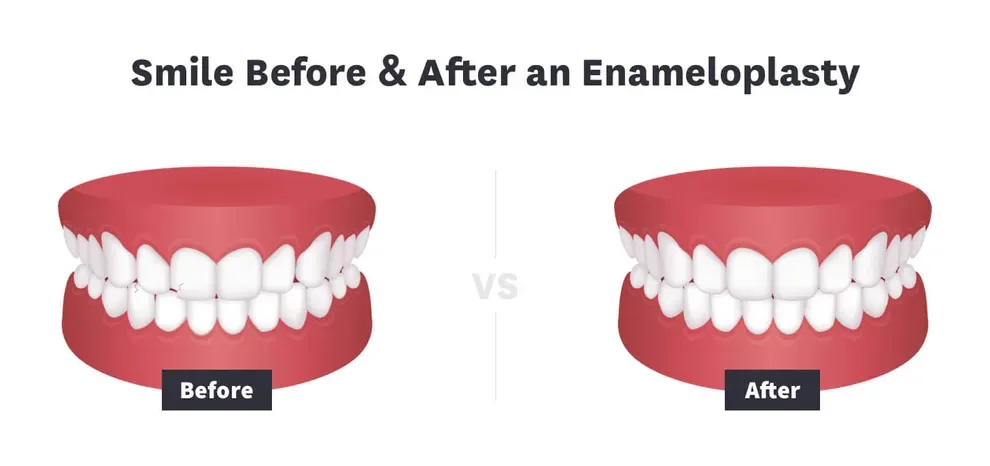Enameloplasty: When Do You Need It & What Is the Cost?

Table of Contents
- What Is Enameloplasty?
- When Is It Needed?
- Odontoplasty vs. Enameloplasty
- The Procedure
- How to Fix Teeth without Enamel
- Costs
- Recovery & Aftercare
Enameloplasty is also called odontoplasty, and it involves reshaping, or recontouring, your tooth’s enamel. This can be done to fix shape, size, or minor imperfections, such as chips in the tooth.
Enameloplasty can enhance your smile and improve your oral hygiene by helping to smooth out areas that can be difficult to keep clean.
This procedure is quick and painless, with virtually no recovery time. It is a relatively inexpensive cosmetic procedure in the world of cosmetic dentistry. It is not generally covered by dental insurance.

What Is Enameloplasty?
Enameloplasty can improve self-esteem by giving you a “smile makeover.”
Over half (61 percent of Americans) wish they could change something about their teeth, and 7 out of 10 Americans are self-conscious about their teeth.
Enameloplasty reshapes the top layer (the enamel) of your teeth to make them more even, aesthetically appealing, and easier to care for. During the procedure, a dentist uses specialized tools to contour your teeth to the desired shape and size, and buff out any imperfections.
When Is Enameloplasty Needed?
Enameloplasty can help to fix small and minor imperfections in the teeth. It is not ideal for bigger issues, as it involves removing some of the tooth enamel.
If you have thin enamel, you probably want to look at a different procedure. Once enamel is removed, it will not regenerate. Enamel is essential to protect your teeth.
Enameloplasty is fairly conservative. It is best for people who are looking to fix minor details with their teeth. It can be used to:
Fix chips and small cracks.
Reshape irregularly shaped teeth.
Remove minor tooth overlapping.
Even out poorly aligned teeth.
Enameloplasty can be more than just a cosmetic procedure in some instances. It can be used to remove tooth decay and prevent future damage to the teeth. It can also be combined with additional procedures, such as placing sealants or tooth bonding to restore teeth and prevent future teeth decay.1
Enameloplasty can be useful during restorative procedures, like crown lengthening procedures, to reshape the teeth in a minimally invasive manner.2
Additionally, when your teeth overlap slightly, it can be difficult to clean in those spaces. Enameloplasty can smooth out the area and make it easier to brush and floss, helping to prevent plaque and tartar buildup.
Odontoplasty vs. Enameloplasty
The term odontoplasty is also used as a term for enameloplasty. These are not two different procedures.
Other terms for this treatment include tooth reshaping and dental recontouring.
The Procedure for Reshaping the Tooth
Enameloplasty is a short procedure that usually takes around 30 minutes or so to complete.
The dentist will usually start by taking x-rays to determine the health of your teeth, depth of the enamel, and whether or not you are a good candidate for the procedure. If you are, the dentist will usually mark the areas of your teeth that need to be sculpted.
There are no pain receptors in your tooth’s enamel, so no medications are needed, and you will not feel any pain. The dentist will generally use a sanding drill with a laser or a diamond bur to slowly remove a small part of your enamel to reshape the tooth.
Chips, factures, pits, or grooves can be smoothed out. Abrasive strips are used between your teeth to make them more even and smooth.
Your dentist will then check to ensure that your bite is aligning the way it should and polish your teeth. The procedure is fast and painless. It can generally be completed in one visit.
How to Fix Teeth without Enamel
If you have thin or damaged enamel, you are likely not a candidate for enameloplasty, as the procedure requires part of the tooth enamel to be removed. This can also be an issue for those who experience tooth sensitivity. Removing enamel can make the teeth more sensitive.
Those with enamel issues may want to consider other cosmetic procedures, including these:
Veneers
Bonding
Whitening
Crowns
Inlays and onlays
At-home clear teeth aligners
Costs Involved with Enameloplasty
We used the BlueCross BlueShield Dental Care Pricing Tool to determine how much an enameloplasty might cost. We used the dental code D9970 and the ZIP code 90001. Based on that data, the enameloplasty cost is $150 to $250.
Several factors can influence the final cost of enameloplasty, including the following:
Your location: If you live in an area with a low cost of living and many dentists, your cost for the procedure could be smaller than that we’ve listed.
Your oral health: If the procedure requires longer treatment times, your dentist may charge more.
You typically won’t need follow-up care for an enameloplasty. Your tissues won’t need time to heal, and your dentist won’t need to monitor your progress. However, you may need to pay for your initial appointment, at which your doctor said you needed this care.
Insurance Coverage for Enameloplasty
The National Association of Dental Plans says most dental plans typically cover preventive care (such as cleanings), restorative care (such as fillings), endodontics (such as root canals), and oral surgery (such as tooth removal). Cosmetic procedures, such as enameloplasty for a prettier smile, may not be covered. However, if enameloplasty is needed due to trauma to the tooth or as part of a procedure to remove tooth decay or stabilize a tooth, your dental insurance may help to cover a portion of the costs as restorative care.
If your dental insurance plan will cover enameloplasty, you’re typically required to pay about half of the bill yourself. If your insurance won’t pay for the treatment, you must pay the entire bill yourself.
How Can You Pay for Enameloplasty?
If your insurance plan doesn’t cover enameloplasty, you have several options available. Investigating them could help you make a smart decision for your smile and your budget.
You could pay for enameloplasty via one of the following options:
Payment plans: Some dentists will give their patients the opportunity to cover the cost in installments.
Price breaks: Some dentists offer discounts to patients who pay their entire bill at once.
Savings: If you have a health savings account (HSA) or a flexible spending account (FSA), you could use those balances to pay for your care.
How Does Enameloplasty Compare?
When considering enameloplasty cost, it could be helpful to consider fees associated with other cosmetic dental procedures. This table may help.
| What Is It? | Cost |
Enameloplasty | Filing down uneven parts of a tooth | $150-$250 |
Veneers | Thin shells are bonded to the front of the tooth | $500-$1,100 per tooth |
Bonding | A resin is applied to the tooth and hardened with a light or laser | $300-$600 per tooth |
Braces | Brackets glued to the teeth connect to wires that guide them to new positions | $5,000-$6,000 (metal versions—others cost more) |
Aligners | Trays wrap around the teeth and are swapped to shift them to new positions | $1,000-$3,000 (at-home versions—in-person aligners cost more) |
Sources: BlueCross BlueShield, Consumer Affairs, CostHelper 1, CostHelper 2
Recovery & Aftercare
There is virtually no recovery time for enameloplasty, and you will feel ready to continue with your daily life right away. It is important to take good care of your teeth after the procedure by practicing good oral hygiene.
You can take care of your teeth best after an enameloplasty by doing the following:
Brush your teeth at least twice per day.
Use a soft-bristled and angled toothbrush.
Brush for at least two minutes each time with a fluoride and nonabrasive toothpaste.
Minimize sugary, starchy, and sticky foods, and limit snacking between meals.
Floss daily.
Stay away from tobacco products.
Do not chew on things that are not food, which can further wear down your enamel or cause chips or cracks.
Keep up with regular dental checkups and cleanings.
